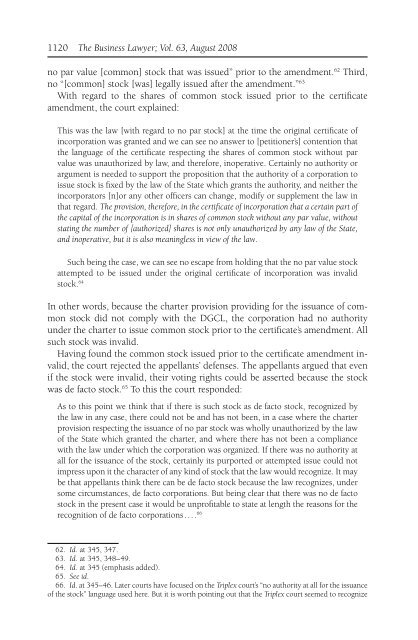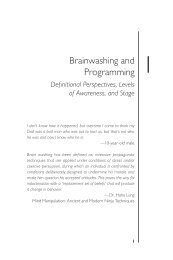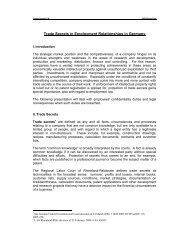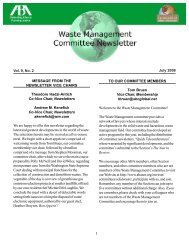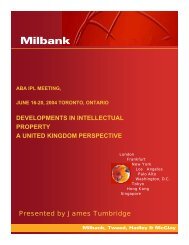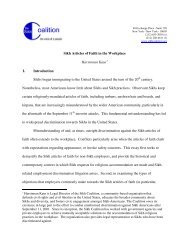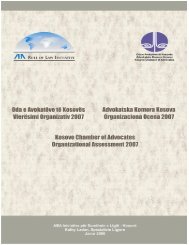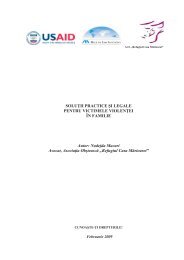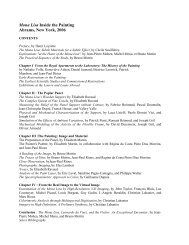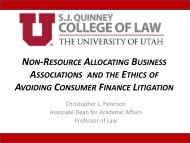Curing Defects in Stock Issuances - American Bar Association
Curing Defects in Stock Issuances - American Bar Association
Curing Defects in Stock Issuances - American Bar Association
Create successful ePaper yourself
Turn your PDF publications into a flip-book with our unique Google optimized e-Paper software.
1120 The Bus<strong>in</strong>ess Lawyer; Vol. 63, August 2008<br />
no par value [common] stock that was issued” prior to the amendment. 62 Third,<br />
no “[common] stock [was] legally issued after the amendment.” 63<br />
With regard to the shares of common stock issued prior to the certifi cate<br />
amendment, the court expla<strong>in</strong>ed:<br />
This was the law [with regard to no par stock] at the time the orig<strong>in</strong>al certifi cate of<br />
<strong>in</strong>corporation was granted and we can see no answer to [petitioner’s] contention that<br />
the language of the certifi cate respect<strong>in</strong>g the shares of common stock without par<br />
value was unauthorized by law, and therefore, <strong>in</strong>operative. Certa<strong>in</strong>ly no authority or<br />
argument is needed to support the proposition that the authority of a corporation to<br />
issue stock is fi xed by the law of the State which grants the authority, and neither the<br />
<strong>in</strong>corporators [n]or any other offi cers can change, modify or supplement the law <strong>in</strong><br />
that regard. The provision, therefore, <strong>in</strong> the certifi cate of <strong>in</strong>corporation that a certa<strong>in</strong> part of<br />
the capital of the <strong>in</strong>corporation is <strong>in</strong> shares of common stock without any par value, without<br />
stat<strong>in</strong>g the number of [authorized] shares is not only unauthorized by any law of the State,<br />
and <strong>in</strong>operative, but it is also mean<strong>in</strong>gless <strong>in</strong> view of the law.<br />
Such be<strong>in</strong>g the case, we can see no escape from hold<strong>in</strong>g that the no par value stock<br />
attempted to be issued under the orig<strong>in</strong>al certifi cate of <strong>in</strong>corporation was <strong>in</strong>valid<br />
stock. 64<br />
In other words, because the charter provision provid<strong>in</strong>g for the issuance of common<br />
stock did not comply with the DGCL, the corporation had no authority<br />
under the charter to issue common stock prior to the certifi cate’s amendment. All<br />
such stock was <strong>in</strong>valid.<br />
Hav<strong>in</strong>g found the common stock issued prior to the certifi cate amendment <strong>in</strong>valid,<br />
the court rejected the appellants’ defenses. The appellants argued that even<br />
if the stock were <strong>in</strong>valid, their vot<strong>in</strong>g rights could be asserted because the stock<br />
was de facto stock. 65 To this the court responded:<br />
As to this po<strong>in</strong>t we th<strong>in</strong>k that if there is such stock as de facto stock, recognized by<br />
the law <strong>in</strong> any case, there could not be and has not been, <strong>in</strong> a case where the charter<br />
provision respect<strong>in</strong>g the issuance of no par stock was wholly unauthorized by the law<br />
of the State which granted the charter, and where there has not been a compliance<br />
with the law under which the corporation was organized. If there was no authority at<br />
all for the issuance of the stock, certa<strong>in</strong>ly its purported or attempted issue could not<br />
impress upon it the character of any k<strong>in</strong>d of stock that the law would recognize. It may<br />
be that appellants th<strong>in</strong>k there can be de facto stock because the law recognizes, under<br />
some circumstances, de facto corporations. But be<strong>in</strong>g clear that there was no de facto<br />
stock <strong>in</strong> the present case it would be unprofi table to state at length the reasons for the<br />
recognition of de facto corporations . . . . 66<br />
62. Id. at 345, 347.<br />
63. Id. at 345, 348– 49.<br />
64. Id. at 345 (emphasis added).<br />
65. See id.<br />
66. Id. at 345– 46. Later courts have focused on the Triplex court’s “no authority at all for the issuance<br />
of the stock” language used here. But it is worth po<strong>in</strong>t<strong>in</strong>g out that the Triplex court seemed to recognize


